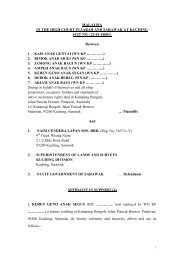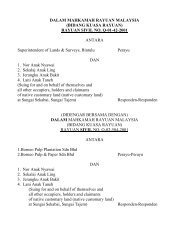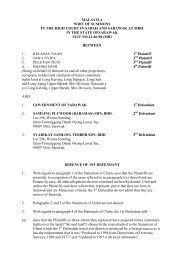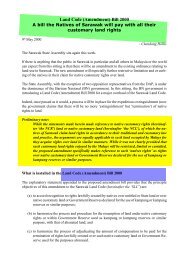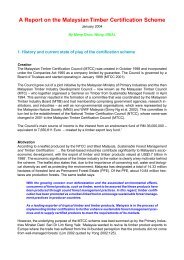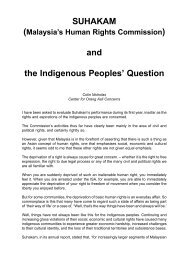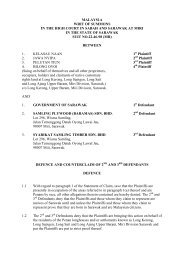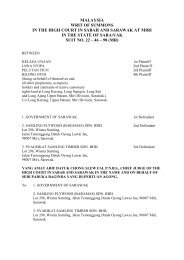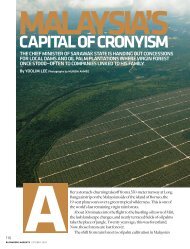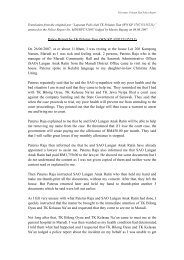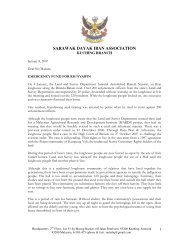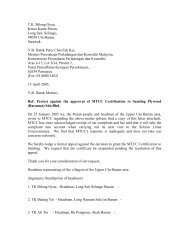Bengoh Writ of Summons - Rengah Sarawak
Bengoh Writ of Summons - Rengah Sarawak
Bengoh Writ of Summons - Rengah Sarawak
You also want an ePaper? Increase the reach of your titles
YUMPU automatically turns print PDFs into web optimized ePapers that Google loves.
5.2 The pioneering group who migrated from Rabak Mikabuh and<br />
settled in the present Kampung <strong>Bengoh</strong> NCR Land were 38 families<br />
and they constructed 4 longhouses known as Kupo (also called<br />
Kupuo) Saba, Kupo Samok, Kupo Sampu and Kupo Tanjung. The<br />
remaining structures <strong>of</strong> these longhouses are still preserved and<br />
houses in the kampong are not built on and around these sites<br />
which are considered as sacred for the villagers <strong>of</strong> Kampung<br />
<strong>Bengoh</strong>.<br />
5.3 In the early 1930s, some families in Kampung <strong>Bengoh</strong> moved<br />
downstream and settled at the present day Kampung Danu.<br />
5.4 The history <strong>of</strong> Kampung <strong>Bengoh</strong> dated back to the early nineteen<br />
century and during the reign <strong>of</strong> the Brunei Sultanate as one <strong>of</strong> the<br />
earliest village headman named Sentus was bestowed the title<br />
Panglima by the then Brunei Sultan and Panglima Sentus has<br />
always been remembered and referred to as one <strong>of</strong> the most<br />
respected Bidayuh leaders.<br />
5.5 A <strong>Bengoh</strong> Mission School was built in Kampung <strong>Bengoh</strong> in 1951 to<br />
provide primary school education for the children in the village.<br />
The primary school was later renamed <strong>Bengoh</strong> District Council<br />
School in or about 1963 and later named Sekolah Kebangsaan<br />
<strong>Bengoh</strong> in the 1980s and maintains as such until today.<br />
5.6 The people <strong>of</strong> Kampung <strong>Bengoh</strong> has been occupying cultivating<br />
and staying within the NCR Land for numerous generations. They<br />
practice the traditional shifting cultivation for their livelihood on<br />
their plots <strong>of</strong> ancestral farmland and plant fruit trees on the same.<br />
They also hunt, fish and collect jungle produces in the communally<br />
owned forests (called “pulau tuaan” in local Bidayuh language).<br />
5.7 Within Kampung <strong>Bengoh</strong>’s NCR land, cultivation particularly<br />
shifting cultivation <strong>of</strong> padi was and is carried out at the foot <strong>of</strong> the<br />
mountain ranges, and in the valleys and the localities <strong>of</strong> land for<br />
farming and cultivation are referred to in local Bidayuh names such<br />
as Tana Sadera, Tana Siparan, Tana Kurang, Tana Merusung, Kan<br />
Sibireh, Kan Darod, Tang Tas, Tana Sapong, Tana Tampang, Tana Eris,<br />
Tana Bang Ken, Tana Stubong, Rabak Kap, Tana Sipunged, Kan Darod,<br />
Tana Tabu, Tana Giruyen, Tana Sturad, Tana Ranta and others.<br />
7



